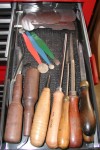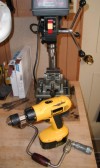- 10" Nicholson Cabinet rasp or half round Stanely Surform rasp
- 10" Nicholson #50 Pattern Makers rasp
- 10" flat bastard*
- 10" flat smooth*
Tool List
The tools that each gun builder owns and uses will vary from person to person depending on individual skills, experience, and money. However, there are a good number of basic tools that all muzzle loading gun builders are going to need. Listed below are the tools that I think every gun builder should have in order to build custom guns from a stock blank and commercially available parts. There are some professional builders who get along with less than what I have listed, but most have more. I think these are the essentials. For harder to find items, the listed item is linked to the online catalog of a recommended vendor. Many of the common tools can be acquired from a good local hardware store or home center. The items in red are the minimum tools required for a beginner assembling a good parts kit. If you plan to install a vent liner or drum, then a drill press is also required.
- 10" Nicholson Cabinet rasp or half round Stanely Surform rasp
- 10" Nicholson #50 Pattern Makers rasp
- 10" flat bastard*
- 10" flat smooth*
10" half round bastard* 8" half round smooth* 8" square bastard* Bend up the tang on one to use in the barrel channel. 8" round bastard* Bend up the tang on one to clean up the ramrod groove. 8" round smooth* 8" three-square smooth* 6" knife bastard for cutting screw slots* 6" barrette Swiss Pattern #2(Brownells) 6" dovetail Swiss Pattern #2(Brownells) Jewelers files set Smooth rifler files set (WoodCraft) Chalk to keep your files from clogging File card with a nylon or brass brush to clean your files
- Set of bench chisels. (minimum 1/4", 3/4")
- 2mm #1 double bevel
- 5mm #1 skew double bevel
- 6mm #21 dog leg
- 12mm #3 gouge
- 7mm #9 gouge
- Carving mallet
For carving add:
A large Xacto knife or chip carving knife with a straight edge for inletting
and carving
Standard set of cabinet scrapers with a burnisher
Jerry Fisher stock scrapers (Brownells)
Scrapers for the barrel channel and ramrod groove. I forged mine out of old files. Peter Alexander describes how to make some similar ones in his new book listed in the Essentials section of the Books & Video page.
Small block plane for shaping the comb, lock panels, and forearm
Soft and Hard Arkansas multiform stones/slips for sharpening
chisels
Washita, Soft and Hard Arkansas bench stones and Sharpening oil
Leather strop - Suggest a thick(1/8"+) piece of leather glued to a block of wood
Set of hard arkansas hones/files (square, round, triangular) for tuning your lock
A set of old fashioned flat blade screw drivers. You should file all your screw slots for tapered screw driver blades.
12"+ bandsaw or
bow saw (Woodcraft)
(Woodcraft)
Dovetail saw or small back saw with the set hammered out.
Hacksaw (24 & 32 tpi blades)
5" throat jewelers saw, blades, and birds mouth (R.E. Davis).
Soft and hard tipped hammer for fitting parts and driving pins
8oz ball peen hammer
Set of pin punches
Brace, variable speed electric hand
drill, or drill
press. All are
recommended but an electric hand drill will do. I actually use my
Dewalt,
cordless, drill/driver most of the time and highly recommend it. You will need a good
vise for use with the drill press.
Complete set of fractional, letter, and number HSS twist drills(minimum 1/16",5/64",3/32",1/8",5/32",3/16",#29,#21).
Ramrod drills in sizes as needed.(Track of the Wolf)
Tap wrench and tap sets for 8-32 and 10-32 (5/16-32 and 3/8-32 for White Lightnin vent liners)
1/2" - 60 & 90 degree countersinks*
HSS rotary file/burr (7/16",1/2",9/16")* for crowning muzzle of barrel
Automatic center punch
6" Dial Caliper
6" combination square
6" machinists rule
Outside caliper
Dividers
Needle nose pliers
Vise Grip pliers
Large adjustable wrench to remove/install breech plug
Mainspring vise for removing your locks mainspring
3" "C" clamps
Candle, candle holder, and kitchen matches for marking parts for inletting the old fashioned way. I use a large permanent marker most of the time.
The most important tools are a good workbench and vise. A very solid 36" x 24" bench will do. A 60" x 24" bench would be better. You could certainly build a serviceable bench out of standard 2" Douglas fir or southern yellow pine. Of course, 3" white oak would be best. If you don't use mortise and tennon construction, make sure you bolt or screw it together. Any bench will need to be screwed to the wall.
I recommend a minimum 4 1/2" machinist’s vise with a 180 degree swivel mount. A good machinists vise such as a Wilton Tradesman can be pretty expensive but you should be able to find a good vise for less money. The older Craftsman machinist vises were pretty good and less than a $100. You can also get an old post vise in good condition for less than $100. There are generally a number of posts vises listed on ebay at any given time. The only problem with a post vise is that it doesn't rotate, but it is historically correct.
You will also need a stock support the approximate height of the vise about 16"-18" away. I suggest that you make it out of 2" oak. When clamping the stock in the machinists vise, I always use wood jaw liners. These liners are two rectangular pieces of ¾" oak a little wider than the jaws and long enough to accommodate a slot to fit over the vise’s main screw. You can see my stock support and vise jaw liners in the pictures below. I also have metal liners made of lead that I use when holding delicate metal parts.
| American Longrifles Home | Gun Building Home |
This page was last updated on 04/01/05 .